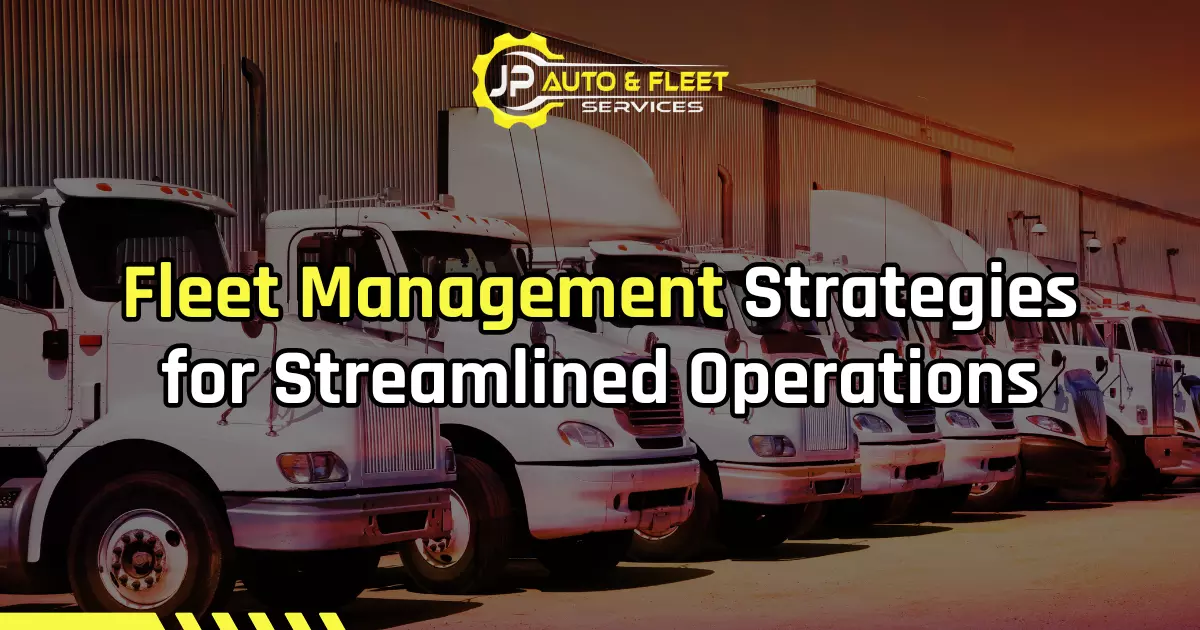Fleet management is crucial for optimizing the performance, efficiency, and safety of a company’s vehicle fleet. It involves a range of activities including vehicle maintenance, driver management, fuel consumption tracking, and compliance with government regulations. Effective fleet management can lead to significant cost savings, improved customer satisfaction, and enhanced operational efficiency. It also plays a vital role in ensuring the safety of drivers and the public, as well as minimizing the environmental impact of fleet operations.
This article delves into advanced fleet management strategies aimed at streamlining operations and maximizing efficiency. It covers a spectrum of topics from leveraging technology for better route planning and vehicle tracking to implementing eco-friendly practices and ensuring regulatory compliance. Whether you’re a seasoned professional or new to fleet management, our actionable tips will guide you toward operational excellence. Continue reading to unlock the full potential of your fleet.
Why is Fleet Management Important?
Fleet management is essential for ensuring optimal performance and efficiency. Having effective strategies in place allows business owners to achieve seamless fleet operations. Let’s explore how they contribute to the success of a fleet.

1. Minimize Repair and Maintenance Costs
One of the primary goals of fleet management is to cut repair costs associated with vehicle breakdowns and unexpected maintenance issues. With proactive routine maintenance and regular inspections, fleet managers catch issues early. This cuts repair costs and fleet maintenance costs. Plus, it keeps different types of vehicles such as commercial vehicles, company vehicles, and government vehicles working well.
Fleet managers can also find ways to reduce maintenance costs without sacrificing the quality or reliability of their fleet assets. For example, they can negotiate favorable maintenance contracts and purchase parts in bulk when repairs are not urgent. This saves costs. Also, they can leverage technology for streamlined maintenance processes. Optimizing resources can even reduce expenses to achieve long-term savings.
2. Optimize Fleet Maintenance and Assets
Another key goal of fleet management is to optimize fleet maintenance processes to ensure the most efficiency and effectiveness. Planning and scheduling preventative maintenance tasks leads to minimal downtime and disruption. Also, staying ahead of maintenance needs and addressing issues on time ensure fleet assets remain operational.
On the other hand, effective management can maintain fleet assets that help maximize lifespan. This involves tracking different asset types’ usage and performance metrics to identify ways to optimize. By fleet optimization, managers improve efficiency and cut maintenance costs.
Read also: Ultimate Guide to Fleet Maintenance
3. Reduce Fuel Costs
Regarding decreasing fuel costs, fleet managers can track fuel consumption and put fuel-saving strategies in place. These strategies include route optimization and driver training programs. This contributes to cost savings and creates an environmental impact.
4. Enhance Fleet Safety
In fleet management, safety is a top priority. Having safety policies and training programs helps drivers, passengers, and others to be safe. Fleet managers can use technology like telematics to track driver behavior and risks. Through this, it minimizes accident risks and also protects the organization’s reputation as well as saves lives.
5. Ensure Compliance with Regulations
Compliance with industry regulations and standards is another important goal of fleet management. This includes adhering to safety regulations, environmental regulations, and other legal requirements governing fleet operations. Fleet managers can stay updated on regulations and ensure compliance.
How Can Telematics Technology Enhance Fleet Operations?

Telematics technology has revolutionized the way fleet managers oversee their operations. They provide real-time insights into vehicle performance, location, and driver behavior. Telematics uses GPS and onboard diagnostics to gather data about fleet vehicles. This data is then analyzed and used to make informed decisions that optimize fleet performance and efficiency.
Here are some key benefits of leveraging telematics technology in fleet management.
1. Real-Time Vehicle Tracking
Fleet managers can use telematics to track the exact location of each vehicle in their fleet in real-time. This helps coordinate routes better, respond faster to customers, and improve fleet visibility.
2. Performance Monitoring
Telematics technology enables fleet managers to track vehicle performance metrics such as fuel consumption, engine health, and mileage. Analyzing this data helps fleet managers find maintenance issues early. They can schedule tasks better which cuts vehicle downtime. This also extends the lifespan of various fleet vehicles.
3. Driver Behavior Analysis
Telematics systems can also track driver behavior including speed, harsh braking, and idling time. The data helps managers find unsafe driving habits. This way, fleet managers can then take corrective actions like driver training. This proactive approach keeps drivers safe and cuts accident risks.
4. Cost Savings
Lastly, telematics technology plays a pivotal role in reducing maintenance costs. Through continuous monitoring, fleet managers can have real-time data on vehicle health and performance. Telematics systems can predict potential issues before they escalate into costly repairs. This predictive maintenance approach allows for timely interventions and prevents minor problems from turning into major breakdowns. Plus, telematics aids in optimizing routes which can lead to less wear and tear on vehicles. By analyzing driving patterns, fleet managers can also identify and correct inefficient driving behaviors that contribute to premature vehicle degradation.
What Role Does Preventive Maintenance Play in Fleet Management?
Preventive maintenance is crucial for fleet management. In a nutshell, it keeps vehicles in good shape. This also cuts unexpected breakdowns. Moreover, regular service schedules help managers find and fix issues early. Here are some key reasons why preventive maintenance is essential in fleet management.
Prevent Breakdowns
Preventive maintenance significantly reduces the likelihood of vehicle breakdowns. This is by systematically addressing potential issues before they escalate. This approach involves regular inspections, timely repairs, and the replacement of worn parts. All these help vehicles to operate under optimal conditions. Identifying and rectifying minor problems during routine checks prevents these issues from developing into major failures. Remember that major failures could lead to unexpected and costly breakdowns. With fewer vehicle malfunctions, managers can enhance the reliability and performance of the fleet and minimize the risk of accidents.
Read also: How to Hire A Mechanic for Your Vehicle or Fleet?
Extend Vehicle Lifespan
Through regular upkeep and early detection of issues, preventive maintenance can extend the lifespan of fleet vehicles. This involves scheduled servicing, inspections, and repairs which help in maintaining vehicle components in optimal condition. By proactively addressing wear and tear, it minimizes the risk of significant breakdowns that can lead to extensive damage and shorten a vehicle’s usable life. Regular oil changes, tire rotations, brake inspections, and engine checks keep vehicles running smoothly. This systematic approach preserves the mechanical integrity of the fleet. Most importantly, it keeps vehicles reliable and efficient over a longer period.
Enhance Safety
Preventive maintenance is a cornerstone of enhancing safety in fleet management. By scheduling regular check-ups and repairs, fleet managers can ensure that vehicles are in optimal condition. It can significantly reduce the risk of accidents caused by vehicle failure. This proactive approach includes routine inspections of brakes, tires, lights, and other critical components, ensuring they meet safety standards.
It also helps identify potential hazards before they lead to serious issues. This maintains the reliability and safety of the fleet on the road. Ultimately, this practice not only safeguards drivers and the public. It also promotes a culture of safety and responsibility within the organization.
Support Compliance
Lastly, preventive maintenance ensures vehicles adhere to legal and industry standards. Regular maintenance checks and services cover all aspects of a vehicle. It inspects emissions and safety features to meet regulatory requirements. This proactive approach helps in identifying and rectifying compliance issues before they result in violations, fines, or downtime. By maintaining thorough maintenance records, fleet managers can provide tangible proof of compliance during audits or inspections. Doing so demonstrates a commitment to safety and regulatory adherence.
How Can Route Optimization Improve Fleet Efficiency?
Route optimization significantly enhances fleet efficiency by leveraging advanced algorithms to determine the most efficient paths for vehicles. This process takes into account various factors such as traffic conditions, road closures, delivery windows, and vehicle capacity. These factors allow drivers to take the shortest, fastest routes with minimal delays. Minimizing unnecessary mileage and detours reduces fuel consumption and slashes fuel costs. Hence, route optimization leads to substantial cost savings and a lower environmental footprint.

Additionally, route optimization enhances customer satisfaction by improving the reliability and punctuality of deliveries or services. It increases the number of deliveries or service calls that can be completed within the same timeframe. This is another benefit as it boosts efficiency. This efficiency also allows for more flexible and responsive service. Fleets can more easily adapt to last-minute changes or emergency calls. On top of that, the data collected through route optimization efforts can provide valuable insights into fleet performance and customer needs. This enables more informed decision-making and strategic planning. By reducing driver stress and fatigue through more direct and less congested routes, route optimization also contributes to safer driving conditions.
Incorporating real-time data analytics into route optimization offers an additional layer of efficiency. This dynamic approach adjusts routes in response to real-time conditions such as traffic updates, weather changes, and unexpected roadblocks. By doing so, fleets can maintain optimal performance even under unforeseen circumstances. This real-time adjustment capability minimizes delays and disruptions. Lastly, the integration of route optimization with other fleet management systems such as telematics and vehicle maintenance schedules creates a cohesive ecosystem. This holistic approach optimizes and maximizes every aspect of fleet operations.
Why is Driver Training Essential for Streamlined Fleet Operations?
Driver training stands as a cornerstone of efficient fleet maintenance. Comprehensive training programs equip drivers with valuable knowledge and skills. It also enhances both their safety and the longevity of fleet vehicles. If you are a fleet manager, you can empower drivers with ongoing education and coaching. This helps them make informed decisions on the road as well as reduces the likelihood of accidents and emergency repairs.
Also, educating drivers on fuel-efficient driving techniques and proper vehicle maintenance reduces fuel consumption and associated costs. This contributes to cost savings and contributes to sustainability goals and regulatory requirements.
Moreover, driver training programs enhance customer satisfaction by ensuring timely and reliable deliveries. Well-trained drivers navigate road conditions, plan routes, and handle unexpected situations. This minimizes downtime and improves service levels. Investing in driver training and ongoing education maximizes fleet performance and reduces labor costs. Remember that driver training is a fundamental aspect of streamlined fleet operations. With far-reaching implications for safety, fuel efficiency, and customer satisfaction, your business can grow and succeed.
What are The Emerging Trends Shaping The Future of Fleet Management?
The future of fleet management is being shaped by a wave of technological innovations. All these technologies promise to revolutionize the way businesses operate their fleets. This includes electronic vehicles, autonomous technology, and predictive analytics. Let’s talk about each one below.
Electric vehicles (EVs) are becoming a focal point in fleet management. They are offering a sustainable alternative to a traditional fuel-powered type of vehicle. Advancements in battery technology and infrastructure position EVs to reduce fuel costs. If you want to create a positive environmental impact, this is ideal for you. It mitigates the risk of unexpected downtime linked to maintaining internal combustion engines.
Autonomous technology is another game-changer in fleet management. Its best selling points are enhanced safety, labor productivity, and fleet uptime. By integrating autonomous features like adaptive cruise control and lane-keeping assistance, fleet managers can improve driver safety. They can also optimize route efficiency and reduce the risk of accidents caused by human error.
Predictive analytics is also emerging as an advanced tool in fleet management. This enables businesses to expect corrective maintenance needs and optimize vehicle use. It also includes enhanced customer fleet services. By using data from sensors and telematics devices, fleet managers identify patterns and trends. This enables proactive decision-making. It boosts customer satisfaction and improves the bottom line.
Electronic vehicles, autonomous technology, and predictive analytics are brightening the future of fleet management with promising possibilities. By staying ahead of these emerging trends and embracing new technologies, businesses can position themselves for success in an evolving landscape.
How Can Data Analytics Drive Continuous Improvement in Fleet Performance?

Data analytics holds the key to unlocking continuous improvement in fleet performance. With analytics, fleet managers can have invaluable insights into their operations. Then, they can use these to analyze fleet metrics. Data are valuable in identifying trends and making data-driven decisions that optimize operations and enhance efficiency. Here’s how data analytics can help your business.
1. Analyze Fleet Metrics
Data analytics allows fleet managers to transform raw data from fleet operations into actionable insights. By analyzing fleet metrics such as fuel consumption, vehicle utilization, and maintenance histories, managers gain a comprehensive understanding of their fleet’s performance. This deep dive into the data reveals patterns and trends that might not be evident at first glance. For instance, a consistent rise in fuel consumption across the fleet could indicate inefficient driving practices or the need for vehicle maintenance. Similarly, analyzing vehicle utilization data helps identify underused assets that could be better allocated.
Maintenance records, when examined closely, can also reveal recurring issues with certain vehicle models or parts. This guides more strategic decisions regarding future purchases or preventive maintenance schedules. The insights enable fleet managers to have targeted interventions that address inefficiencies, reduce costs, and improve the fleet’s overall performance. This continuous loop of analysis, decision-making, and improvement fosters a culture of excellence and innovation within fleet operations.
2. Identify Trends within Fleet Operations
Data analytics equips fleet managers with the tools to identify and understand trends within their fleet operations. The vast amounts of data turn into a roadmap for strategic decision-making. By recognizing trends like increasing fleet repair service costs, declining fuel efficiency, or driver behavior, managers can take proactive measures. For example, a trend of increasing repair costs could signal the aging of the fleet or the need for more rigorous preventive maintenance. Declining fuel efficiency might reveal not just vehicle wear but also areas where driver training on fuel-efficient driving practices could be beneficial. It can also uncover patterns in driver behavior such as harsh braking or speeding. These are crucial for implementing targeted safety and efficiency training programs. Recognizing these trends enables fleet managers to implement proactive measures that not only address current inefficiencies but also preempt potential future challenges. This proactive stance ensures the fleet remains reliable, cost-effective, and aligned with best practices in fleet management.
3. Make Data-Driven Decisions for Optimization
The integration of data analytics into fleet management transforms decision-making from a reactive to a proactive and strategic process. This approach allows for the fine-tuning of operations such as routing and scheduling. It optimizes operations, reduces costs, and enhances efficiency across the entire fleet.
Moreover, data analytics offers a granular view of costs, from fuel consumption patterns to the financial impact of unscheduled repairs. This visibility enables managers to implement targeted strategies to manage and reduce these expenses effectively. For example, data might reveal that certain routes lead to higher fuel consumption. It prompts them to search for more efficient alternatives. Similarly, a pattern of frequent repairs on specific vehicle models could lead to a review. It might also need adjustment of maintenance schedules or even considerations for fleet renewal.
What Strategies Can Companies Implement to Ensure Regulatory Compliance?
Ensuring regulatory compliance in fleet maintenance requires a strategic approach. It’s a multifaceted task. Companies put in place effective strategies to navigate industry regulations and standards. As a result, this safeguards their operations and promotes efficiency across the board.
Prioritizing adherence to driver hours-of-service rules helps companies ensure regulatory compliance. They can also establish comprehensive vehicle inspection protocols and invest in emissions-reducing technologies. Incorporating these strategies into their fleet maintenance programs and management systems helps companies navigate regulatory requirements. It also minimizes risks and promotes operational efficiency.
Here are the strategies that companies can implement to ensure regulatory compliance.
Prioritize Adherence to Driver Hours-of-Service Rules
One of the cornerstone strategies for regulatory compliance is prioritizing adherence to driver hours-of-service rules. These regulations aim to prevent driver fatigue and enhance road safety. This governs the most driving hours and mandatory rest periods for commercial drivers. Companies can reduce the risk of violations and associated penalties by implementing robust scheduling systems and monitoring mechanisms to ensure that drivers follow these rules.
To bolster adherence to driver hours-of-service rules and ensure regulatory compliance, companies can employ several practical tips.
- Implement Electronic Logging Devices (ELDs). Use ELDs to automatically record driving hours. It also leads to accurate and tamper-proof logging. This technology makes it easier to monitor compliance with hours-of-service regulations in real-time.
- Educate Drivers and Dispatchers. Regularly hold training sessions for drivers and dispatchers on the importance of hours-of-service regulations. Understanding the rationale behind these rules can motivate adherence.
- Develop Clear Policies. Establish clear, written policies regarding hours-of-service compliance. Make sure these policies are accessible and understood by all relevant staff members.
- Schedule Proactively. Design schedules that not only comply with hours-of-service regulations but also consider traffic patterns and delivery deadlines. This proactive approach can help avoid the need for drivers to rush, potentially violating regulations.
- Monitor and Review. Regularly review driver logs and ELD data to identify potential compliance issues. Addressing these issues promptly can prevent violations.
- Use Data for Improvement. Analyze compliance data to identify patterns or recurrent issues. Use these insights to refine scheduling practices and training programs.
- Encourage Open Communication. Create an environment where drivers feel comfortable reporting potential compliance issues or concerns without fear of retribution. Open communication can help identify and resolve issues before they become violations.
Establish Comprehensive Vehicle Inspection Protocols
Another crucial aspect of regulatory compliance is conducting regular vehicle inspections to uphold safety standards and regulations. Companies should establish comprehensive inspection protocols and schedules. They should ensure that each vehicle in their entire fleet undergoes thorough inspections. Companies can also maintain compliance and enhance vehicle reliability. This cuts risks associated with accidents or breakdowns by identifying and addressing potential safety issues.
To reinforce the establishment of comprehensive vehicle inspection protocols and ensure regulatory compliance, companies can adopt the following strategies.
- Create a Detailed Inspection Checklist. Develop a checklist tailored to each vehicle type within the fleet. The checklist should cover all critical components such as brakes, tires, lights, and safety equipment. This ensures thorough and consistent inspections.
- Train Inspection Personnel. Ensure that those responsible for inspections are well-trained and understand the importance of each inspection point. Regular training updates can keep them informed about the latest regulatory requirements and safety standards.
- Leverage Technology. Utilize fleet maintenance software to schedule, track, and document inspections. This can help ensure no vehicle misses its inspection and provides an auditable trail of compliance.
- Incorporate Pre- and Post-Trip Inspections. Encourage drivers to conduct pre- and post-trip inspections as part of their daily routine. These inspections can catch issues that may develop between scheduled comprehensive inspections.
- Address Issues Promptly. Implement a system for reporting and addressing issues identified during inspections immediately. Quick resolution of problems not only ensures compliance but also enhances safety and reliability.
- Maintain Records. Keep detailed records of all inspections. In your record include the inspector’s name, date of inspection, findings, and any corrective actions taken. These records are essential for demonstrating compliance during audits.
- Periodic Review of Inspection Protocols. Regularly review and update inspection protocols to reflect changes in regulations, vehicle technology, and fleet composition. This ensures that inspection practices remain relevant and effective.
- Engage with Regulatory Bodies. Stay informed about regulatory changes and engage with regulatory bodies for guidance on compliance. This proactive approach can help companies anticipate and adapt to regulatory changes more effectively.
Invest in Emissions-Reducing Technologies
Compliance with emissions standards is also paramount for companies looking to cut their environmental impact and meet regulatory requirements. Investing in emissions-reducing technologies helps companies reduce their carbon footprint. Adhering to emissions testing requirements demonstrates their commitment to sustainability. Moreover, incorporating friendly technologies into their fleet helps companies follow regulations. It also contributes to a cleaner and greener future.
To effectively invest in emissions-reducing technologies and ensure compliance with environmental standards, companies can consider the following tips.
- Research and Invest in Cleaner Vehicles. Stay informed about the latest advancements in vehicle technology such as electric, hybrid, or alternative fuel vehicles. All these offer lower emissions compared to traditional diesel or gasoline vehicles.
- Implement Idle Reduction Policies. Educate drivers on the impact of idling and implement policies that minimize unnecessary engine idling. This reduces emissions and saves fuel.
- Regular Maintenance Checks. Ensure that vehicles undergo regular maintenance to keep engines running efficiently. Well-maintained vehicles emit fewer pollutants which helps companies stay compliant with emissions standards.
- Retrofit Existing Vehicles. Explore retrofitting options for older vehicles with emissions-reducing technologies like diesel particulate filters or exhaust after-treatment systems. This can be a cost-effective way to reduce emissions from existing assets.
- Monitor and Report Emissions. Use telematics and other monitoring tools to track and report the fleet’s emissions. This data can help identify trends, measure the impact of implemented strategies, and demonstrate compliance with regulatory requirements.
How to Measure Fleet Management Success?

Successful companies understand that measuring fleet management success involves more than counting vehicles on the road. They recognize the importance of comprehensive metrics. It involves a comprehensive evaluation of key performance indicators (KPIs), as this reflects the efficiency and effectiveness of fleet operations. By focusing on these metrics, companies can gauge their performance. They can identify areas for improvement and drive continuous success in fleet management.
Listed here are the key performance indicators (KPIs) you can watch out for.
1. Fuel Efficiency
A crucial KPI for fleet management success is fuel efficiency. Companies can optimize routes and lower operating costs by tracking fuel expenses and implementing fuel-tracking systems. This helps reduce fuel consumption. Moreover, improved fuel efficiency reflects operational efficiency and environmental responsibility. It also translates to cost savings.
To effectively evaluate fuel efficiency within a fleet, consider establishing the following KPIs.
- Miles per Gallon (MPG) or Kilometers per Liter (KPL). This is the most direct measure of fuel efficiency. It indicates how far a vehicle can travel on a unit of fuel. Tracking changes in MPG or KPL over time for each vehicle can highlight trends and identify issues.
- Fuel Cost per Mile/Kilometer. This KPI measures the cost of fuel required to travel a specific distance. It helps in understanding the financial impact of fuel consumption and can be crucial for budgeting and cost reduction efforts.
- Idle Time Percentage. Excessive idling is a major contributor to wasted fuel. Monitoring the percentage of time vehicles spend idling versus in operation can identify opportunities to reduce unnecessary fuel consumption.
- Total Fuel Consumption. Monitoring the total volume of fuel consumed by the fleet over a set period helps in assessing overall fuel efficiency. It also identifies seasonal variations or trends.
- Fuel Efficiency Variance. This KPI compares the actual fuel efficiency of vehicles against their expected performance based on benchmarks or manufacturer data. Variances can indicate issues such as the need for maintenance or driver training.
2. Vehicle Utilization
Effective fleet management involves maximizing the use of fleet vehicles. Monitoring vehicle uptime and use rates helps companies ensure that their assets are being utilized to their full potential. Companies can improve fleet productivity by optimizing vehicle use. This involves minimizing idle time and reducing wear and tear.
To effectively evaluate vehicle utilization within a fleet, here are the KPIs you should track.
- Utilization Rate. This KPI measures the percentage of time a vehicle is in use compared to the total available time. It provides a clear picture of how effectively vehicles are being deployed.
- Vehicle Downtime. Track the amount of time vehicles spend out of service due to maintenance or repairs. Lower downtime indicates higher availability and better utilization.
- Miles or Kilometers Traveled. This KPI measures the distance each vehicle covers within a specific period. It helps assess how actively vehicles are being used.
- Average Load Capacity Utilization. For fleets involved in cargo transport, measuring how much of the available load capacity is being used can indicate how efficiently vehicles are being utilized.
- Cost per Mile/Kilometer. Analyzing the operational cost relative to the distance traveled can provide insights into the economic efficiency of vehicle utilization.
- Revenue per Vehicle. For fleets generating income, measuring the revenue attributed to each vehicle can help assess how effectively vehicles are contributing to the business.
3. Maintenance Costs
Keeping maintenance costs in check is essential for fleet management success. Companies can identify maintenance trends by monitoring expenses and tracking unexpected repairs. This proactive approach helps them address issues before they escalate. Implementing corrective maintenance schedules and alerts for repair systems minimizes downtime. It also reduces overall maintenance costs.
You can evaluate maintenance costs by looking at the following KPIs.
- Total Maintenance Cost. This fundamental KPI tracks the aggregate cost of maintaining the fleet over a specific period. This includes parts, labor, and any unplanned repairs.
- Cost per Vehicle. Divide the total maintenance cost by the number of vehicles in the fleet. This formula helps you assess the average cost per vehicle. It gives you insights into individual vehicles and overall fleet maintenance efficiency.
- Preventive vs. Reactive Maintenance Costs. Tracking the ratio of preventive (scheduled) maintenance costs to reactive (unscheduled, emergency) maintenance costs can highlight the effectiveness of your preventive maintenance program.
- Maintenance Cost per Mile/Kilometer. This KPI measures the maintenance cost relative to the distance traveled by the fleet. It provides a metric for assessing maintenance efficiency over time and across different operational conditions.
- Downtime Cost. Evaluate the cost associated with vehicle downtime due to maintenance. This should include lost revenue and additional expenses to get a comprehensive view of the impact of maintenance practices on the fleet’s bottom line.
- Percentage of Budget Spent on Maintenance. Comparing the maintenance expenditure against the allocated budget for maintenance provides insight into financial management and whether maintenance costs are within expected parameters.
4. Customer Satisfaction
This is a key indicator of fleet management success. Satisfied clients are more likely to be loyal and repeat customers which drives business growth and profitability. Companies can ensure that their fleet operations meet or exceed customer expectations by monitoring customer feedback and satisfaction levels. This fosters long-term relationships and business success.
To evaluate customer satisfaction within fleet operations, implement and track the following KPIs.
- On-Time Delivery Rate. This KPI measures the percentage of deliveries or services completed within the promised time frame. High on-time delivery rates are often directly correlated with high customer satisfaction levels.
- Customer Satisfaction Score (CSAT). This metric is obtained through direct customer feedback. Typically it comes from surveys asking customers to rate their satisfaction with the service on a scale. It provides a straightforward measure of customer satisfaction.
- Net Promoter Score (NPS). NPS is calculated based on customer responses to the question of how likely they are to recommend your services to others. It categorizes customers into Promoters, Passives, and Detractors which offer insights into customer loyalty and satisfaction.
- Service Quality Complaints. Tracking the number and nature of complaints related to service quality can highlight areas needing improvement. It also gives you an idea of how they impact customer satisfaction.
- First-Time Fix Rate. In service-oriented fleets, this KPI measures the percentage of issues resolved on the first visit without the need for a return trip. A high first-time fix rate generally leads to higher customer satisfaction.
- Customer Retention Rate. This metric tracks the percentage of customers who continue to use your services over time. High retention rates are often a strong indicator of overall customer satisfaction.
- Average Resolution Time. For fleets dealing with customer service inquiries or complaints, tracking the average time taken to resolve issues can provide insights into service efficiency and its impact on customer satisfaction.
Wrapping Up
Fleet maintenance is essential for achieving optimal performance and efficiency in fleet operations. In this guide, we’ve explored various strategies and techniques aimed at streamlining fleet management and maximizing productivity. Setting clear objectives and leveraging telematics technology are essential. Additionally, implementing preventive maintenance on time and optimizing routes are crucial steps. Each aspect plays a crucial role in ensuring smooth fleet operations. Driver training, staying abreast of emerging trends, and harnessing the power of data analytics are key components of successful fleet management.
It’s also important to emphasize the significance of implementing comprehensive strategies for maintaining fleet efficiency. Companies can maximize fleet vehicle uptime by managing maintenance activities, utilizing skilled technicians, and adhering to preventive maintenance schedules. Investing in fleet maintenance management programs can provide invaluable support. These programs help oversee preventive maintenance tasks. They ensure vehicles are serviced on time according to manufacturer recommendations.
Remember that effective fleet management requires a holistic approach. It should address all aspects of maintenance, operations, and compliance. By implementing the strategies discussed in this blog, companies can optimize their fleet performance. They can also reduce costs, and achieve long-term success.
Do you need help with your fleet? JP Auto & Fleet Services is here to help you! Contact us today to get expert full-service auto care. We have the expertise needed to keep your personal and commercial vehicles running without issues. We serve our clients from Lewisville, Texas, DFW, TX, and various areas in Dallas-Fort Worth, Texas.


